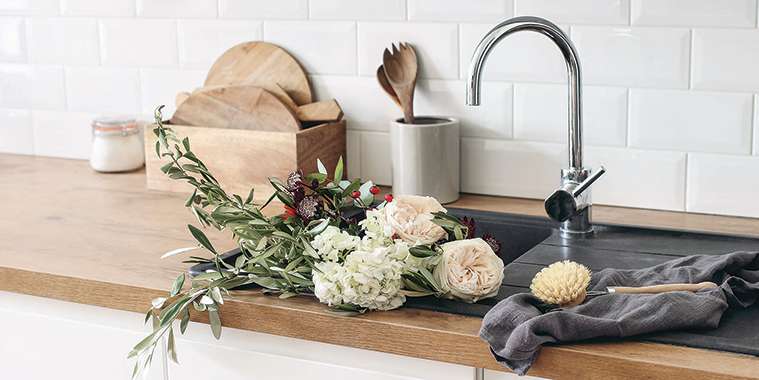When it comes to your kitchen or bathroom countertops, it’s all in the details. When replacing your countertops, you’ll want to choose your edging according to the material and style you’ve chosen. More dramatic or regal edges will only work with quartz, marble or stone, while a straight edge is better for stainless steel or wood tops.
A razor-sharp edge or corner is not only dangerous but also more prone to chipping. Most non-rounded edges, therefore, have a slight kerf or “ease” to them. The degree of ease depends on your aesthetic.
Edges can also be “mitered,” which means assembling an edge from two pieces instead of one. This gives a standard-sized countertop a thicker look without adding extra weight or cost, and can allow for more ornate edges.
The most basic edges are as follows, but they can get more elaborate depending on what architectural style you’re looking for.
Squared
Your basic edge, it works with almost all design styles, for a clean, minimalist look — most squared edges have an ease to them, even if very slight.
Bullnose
With rounded tops and bottoms, bullnose edges give a soft touch to your design. They’re ideal for small children because of the rounded edge on the bottom. Other variations include double bullnose, demi bullnose and open bullnose.
Double Bullnose
This version features bullnose edge and a rounded cap that wraps around an outside corner.
Demi Bullnose
This is another bullnose variation that has a rounded top. Unlike the bullnose, it tapers into a sharper edge at the bottom rather than rounding out completely.
Open Bullnose
An open bullnose is a double-stacked edge, which combines a rounded bullnose with another style, like an ogee, stacked on top.
Ogee
For that traditional look, an ogee edge has a concave arch that flows into a convex arch.
Double ogee
A double ogee edge features even more detail and elegance than the classic ogee, with two “S”-shaped curves stacked atop one another.
Roman ogee
A Roman ogee combines the double bullnose’s rounded outside cap with an ogee edge.
Double flat polish
A double flat edge is a square edge (with a slight ease) on all sides.
Half round
Similar to a double flat edge, a half-round edge only differs in its rounded cap that wraps around an outside corner.
Bevelled
Bevelled edges feature a flattened corner at a 45-degree angle and can be finished in a few different styles. A top bevel only has the top corner flattened, while a double bevel flattens both the top and bottom corners.
Custom
Custom countertop edges can be designed and fabricated to your unique style and are usually a finishing touch for luxury and upscale kitchens. When choosing stone countertops, consider a custom rock face or chiseled edge that exposes the raw stone to give your kitchen a rustic and natural feel.
Replacing your kitchen counters is a big decision and not one you should take lightly. You may want to work with an experienced kitchen designer to select the material, finish and edge that makes the most sense for your taste and lifestyle. Keep in mind there are plenty of other cost-effective ways to give your kitchen a facelift if budget is a concern.
— Realtor.ca



